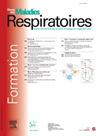Development of cutting-edge preclinical models to study the response of small-cell lung cancer to current therapies
IF 0.5
4区 医学
Q4 RESPIRATORY SYSTEM
引用次数: 0
Abstract
Introduction
Small cell lung cancer (SCLC) is the most aggressive subtype of lung cancer. Although the combination of chemotherapy and immune checkpoint inhibitors has recently shown slight improvement in outcome, the prognosis remains very poor. The development of relevant preclinical models is a crucial step towards new therapies. Here, we present the models we are currently using and developing in the laboratory: xenografts derived from Circulating Tumor Cells from SCLC patients (CDXs), CDXs on humanized mice (Hu-CD34+-NXG), and CDXs on a cutting-edge combination of Hu-CD34+-NXG with controlled gut microbiota (‘MESHCAP’ model, meaning Exogenous Microbiota and Humanized Mice for Lung Cancer).
Methods
CTCs are collected from patients blood at the time of SCLC diagnosis. Isolation is performed by immunomagnetic negative selection, followed by a flow cytometry sorting of CD56+/CD45− cells labeled with fluorescent antibodies.
For CDXs generation, CTCs are injected subcutaneously into immunodeficient NSG mice.
For humanized CDXs, CDXs are subcutaneously grafted into humanized CD34+ NXG mice. To control gut microbiota composition (MESHCAP model), the original microbiota from mice is depleted by a specific cocktail of antibiotics. NXG mice are then inoculated with a specific bacterial consortium prior to CD34+ humanization.
In all three models, subcutaneous tumor growth is monitored manually. When tumor size reaches 1000 mm3, the animals are sacrificed and the tumor removed. Tissues are fixed and used for immunochemistry, or snap-frozen for subsequent genetic or transcriptomic analysis.
Results
We have developed a unique method for isolating live CTCs from the blood of SCLC patients. This EpCAM-independent method is based on the CD56+ marker frequently expressed on the membrane surface of SCLC cells.
To date, we have successfully generated 5 CDXs from CTCs of SCLC patients. These models show rapid tumor growth, supporting the tumorigenic properties of CD56+-CTCs. Initial trials of CDXs grafted onto humanized mice show a partial response to immunotherapy.
Development of our MESHCAP mouse model is underway, and preliminary results on depletion of gut microbiota and humanization of the immune system are encouraging. Our bacterial consortium, supposedly beneficial for immunotherapy, has been cultured and will be inoculated in mice.
Conclusion
We have developed CDX-based mouse models that are relevant and effective for studying response to SCLC treatment. While conventional CDXs models allow us to study response to chemotherapy, inhibitors etc., transplantation of humanized mice broaden research possibilities by enabling us to test immunotherapeutic strategies. We also expect to analyze the impact of gut microbiota composition on immunotherapy with our new MESHCAP mouse model.
开发尖端的临床前模型,研究小细胞肺癌对当前治疗的反应
小细胞肺癌(SCLC)是最具侵袭性的肺癌亚型。虽然联合化疗和免疫检查点抑制剂最近显示预后略有改善,但预后仍然很差。相关临床前模型的开发是迈向新疗法的关键一步。在这里,我们介绍了我们目前在实验室中使用和开发的模型:来自SCLC患者循环肿瘤细胞的异种移植物(CDXs),人源化小鼠的CDXs (Hu-CD34+-NXG),以及Hu-CD34+-NXG与控制肠道微生物群的尖端组合的CDXs (MESHCAP模型,意思是外源性微生物群和人源化肺癌小鼠)。方法在SCLC诊断时采集患者血液中sctc。通过免疫磁阴性选择进行分离,然后用荧光抗体标记的CD56+/CD45−细胞进行流式细胞术分选。为了产生CDXs,将ctc皮下注射到免疫缺陷NSG小鼠中。对于人源化cdx, cdx被皮下移植到人源化CD34+ NXG小鼠中。为了控制肠道微生物群组成(MESHCAP模型),小鼠的原始微生物群被特定的抗生素鸡尾酒耗尽。然后在CD34+人源化之前,用特定的细菌联合体接种NXG小鼠。在所有三种模型中,人工监测皮下肿瘤的生长情况。当肿瘤大小达到1000mm3时,处死动物,切除肿瘤。组织固定并用于免疫化学,或快速冷冻用于随后的遗传或转录组学分析。结果我们开发了一种从SCLC患者血液中分离活ctc的独特方法。这种不依赖epcam的方法是基于SCLC细胞膜表面频繁表达的CD56+标记物。迄今为止,我们已经成功地从SCLC患者的ctc中生成了5个cdx。这些模型显示出快速的肿瘤生长,支持CD56+- ctc的致瘤特性。CDXs移植到人源化小鼠的初步试验显示对免疫治疗有部分反应。MESHCAP小鼠模型的开发正在进行中,关于肠道微生物群消耗和免疫系统人源化的初步结果令人鼓舞。我们的细菌联合体,据说对免疫治疗有益,已经培养并将接种在小鼠身上。结论我们已经建立了基于cdx的小鼠模型,这是研究SCLC治疗反应的相关和有效的方法。虽然传统的cdx模型允许我们研究对化疗,抑制剂等的反应,但人源化小鼠的移植使我们能够测试免疫治疗策略,从而拓宽了研究的可能性。我们还希望通过新的MESHCAP小鼠模型分析肠道微生物群组成对免疫治疗的影响。
本文章由计算机程序翻译,如有差异,请以英文原文为准。
求助全文
约1分钟内获得全文
求助全文
来源期刊

Revue des maladies respiratoires
医学-呼吸系统
CiteScore
1.10
自引率
16.70%
发文量
168
审稿时长
4-8 weeks
期刊介绍:
La Revue des Maladies Respiratoires est l''organe officiel d''expression scientifique de la Société de Pneumologie de Langue Française (SPLF). Il s''agit d''un média professionnel francophone, à vocation internationale et accessible ici.
La Revue des Maladies Respiratoires est un outil de formation professionnelle post-universitaire pour l''ensemble de la communauté pneumologique francophone. Elle publie sur son site différentes variétés d''articles scientifiques concernant la Pneumologie :
- Editoriaux,
- Articles originaux,
- Revues générales,
- Articles de synthèses,
- Recommandations d''experts et textes de consensus,
- Séries thématiques,
- Cas cliniques,
- Articles « images et diagnostics »,
- Fiches techniques,
- Lettres à la rédaction.
 求助内容:
求助内容: 应助结果提醒方式:
应助结果提醒方式:


